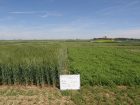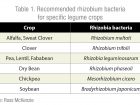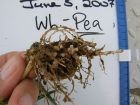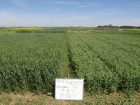
Features
Agronomy
Pulses
Understanding the process of pulses
Legume crops are unique in that they can fix much of their own nitrogen (N) requirements from the air to reduce or eliminate the need for N fertilizer. Legume crops include, alfalfa, clover, soybean, dry pea, bean, lentil, fababean and chickpea.
March 4, 2018 By Ross H. McKenzie PhD P. Ag.
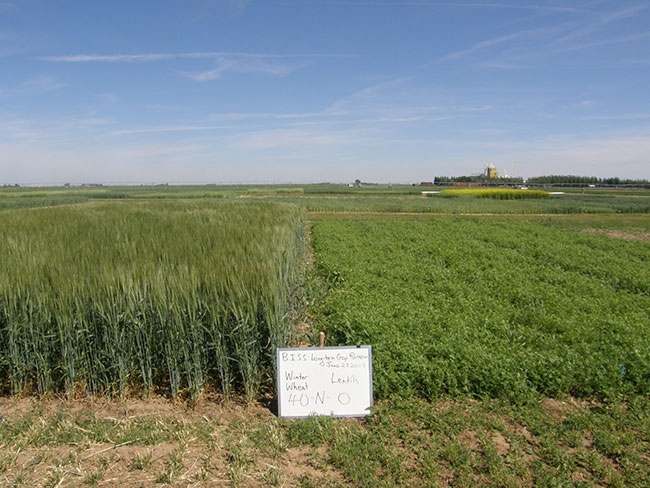 Lentil on right and winter wheat seeded in lentil stubble in long-term rotation plots at Bow Island Legume crops are unique in that they can fix much of their own nitrogen (N)
Lentil on right and winter wheat seeded in lentil stubble in long-term rotation plots at Bow Island Legume crops are unique in that they can fix much of their own nitrogen (N)Legume crops form a relationship with living bacteria called rhizobium. Rhizobia bacteria live in association with legume plant roots to convert N from the air into useable N for the plant.
The atmosphere contains about 79 per cent nitrogen gas. Atmospheric nitrogen gas (N2) exists as two N atoms with very stable bonds that are not easily broken. As a result, N2 is relatively unreactive and not available for uptake by most plants, except for legumes.
Understanding biological nitrogen fixation
Biological N fixation transforms atmospheric N2 gas into plant available N forms by N-fixing bacteria. These bacteria are a broad group of single-celled organisms capable of fixing N by producing nitrogenase, an enzyme that catalyzes the reaction that breaks the strongly bonded N2 gas into ammonia-N (NH3). Nitrogen fixing bacteria can occur as free-living microbes in soil, or as bacteria that live in association with legume plant roots. The N-fixing rhizobia bacteria that live in association with plant roots form nodules on legume roots.
The protective environment of the nodule is ideal for the rhizobia and the nitrogenase enzyme. Legume plants provide carbohydrates to sustain the bacteria. In return, the rhizobia bacteria provide ammonia-N to the plant, which is rapidly assimilated into organic N compounds. The relationship between the N-fixing bacteria and the plants is symbiotic, meaning both the legume plant and the rhizobia bacteria benefit from the mutual association.
Healthy soil contains vast populations of bacteria. Each legume plant requires specific rhizobia bacteria for the symbiotic relationship to form root nodules. For example, the rhizobia bacteria that form symbiosis with pea, lentil and fababean will not form symbiosis with other legumes. Most prairie soils lack the specific rhizobia needed for effective legume nodulation. This means legume seed must be properly inoculated with the correct specific rhizobia bacteria (Table 1).
Rhizobia can live freely in soil for several years, without a legume host plant. When free-living in soil, they survive on dead or decaying organic matter. Introduced rhizobia that survive in soil often gradually lose the ability to fix higher levels of N. As a result, for effective N-fixation to take place, legume crops should always be inoculated.
Nodulation of legume roots
The ability of rhizobia bacteria to infect plant roots is very unique and complex. Plant roots must differentiate between numerous micro-organisms and beneficial rhizobia bacteria. For rhizobia infection of legume plant roots to occur, there are unique multi-step interactions or communications that take place between the legume roots and rhizobia.
The process is very complex, but simply explained, plant root hairs release specific substances called flavonoids, which are used to attract specific rhizobia. Each legume type secretes a different type of flavonoid, therefore only certain rhizobia respond to specific flavonoids. The rhizobia bacterial use flagella, a tail-like structure, to move in the soil solution toward the plant root hairs secreting the specific flavonoid. Movement is limited to a couple of millimetres in the soil. When a plant root is encountered, rhizobia attach to the surface of the root.
Inoculation of specific rhizobia on the legume seed results in nodules clustered near the vicinity of seed placement. When legumes are inoculated with rhizobia bacteria, placement on or very near the seed is essential to ensure contact between the inoculant and legume root hairs.
The root rhizosphere is the zone of soil immediately adjacent to the plant root, that is influenced by root activity. Roots take up nutrients like phosphorus and potassium from this zone. Roots also release nutrient rich exudates into the rhizosphere, which are an excellent source of nutrients for soil microbes including rhizobia bacteria. The abundant nutrition in the rhizosphere promotes rapid multiplication of the bacteria.
Small colonies of bacteria become anchored near the tip of the growing root hairs. The tip of a root hair curls around the rhizobia colony which becomes entrapped by the tip of the root hair. A deformation of the root hair occurs and a nodule develops, which contains the N fixing bacteria.
The plant provides carbohydrate and nutrients to the rhizobia, and in return the rhizobia provide useable N to the plant. There is increasing evidence that the symbiotic relationship between the plant and rhizobia is controlled to restrict too many nodules from forming on root hairs, to optimize the amount of carbohydrate provided by the plant to the rhizobia, and in turn, optimize N provided to the plant for growth.
Scientists have done extensive work over the past 50 years to develop an understanding of the nodulation processes, to isolate the most effective strains of rhizobia bacteria and develop these strains into commercial inoculants to optimize N fixation.
Types and effectiveness of inoculants
An inoculant contains live bacteria that is placed on the seed surface or very near the seed. When purchasing inoculant, always check to ensure it is the correct rhizobium species for the crop being grown and check the expiry date on the inoculant container. After purchasing inoculant, make sure it is stored in a cool, dark environment to maintain the viability of the live bacteria in the inoculant. Always apply the inoculant according to the manufacturer specifications to ensure correct application and rates. Never mix inoculant with fertilizer as this often kills the bacteria.
There are three main types of inoculants:
Powdered – Fine peat containing rhizobia at a specific number per gram, applied directly to the seed. A sticker is usually needed to ensure rhizobia adhere to the seed coat.
Liquid – Contains the rhizobium in a buffered liquid, that is normally applied directly to the seed usually at the time of auguring and is held in place using a sticker. Some liquid inoculants are registered for use in a seed row application. Check label for correct application instructions.
Granular – Small, peat-based or clay based granules contain the rhizobium in a protective environment; the granular product can be accurately metered into the seed row. A separate tank and meter is required on the seeder.
Depending on soil environmental conditions, it takes three-to-five weeks after seeding for bacteria to infect plant roots, form nodules and start fixing N. The effectiveness of the inoculation process can be assessed by simply digging up and examining the plant roots for the number, size, colour and distribution of the nodules.
Nodules on roots close to the original location of the inoculant that are red or pink inside indicate the bacteria are functioning and fixing N. Nodules are likely not fixing N when the inside appears white, grey or greenish. Nodules distributed through the root system may indicate that native soil bacteria have also infected the roots. These bacteria may not function effectively in fixing N to meet plant requirements.
Possible reasons for inoculant failure
Inoculating a legume does not always result in successful N-fixation. When inoculant failure occurs, some possibilities to investigate include:
- Always save a sample of inoculant to check for viability, in-case of inoculant failure
- Was the correct rhizobium species used?
- Was the rhizobia viable? If not, was it due to poor storage?
- Low rate of inoculant used or poor retention of inoculant onto seed surface
- After seed was inoculated – was planting was delayed? If so, the inoculant may not have survived on seed
- If seed bed environmental conditions were warm and dry after planting, desiccation of rhizobia may occur while seed was in dry soil and rhizobia may not survive
- If soils are cold or excessively wet after seeding, the rhizobia may not survive
- If soil nitrate levels are excessively high, this may inhibit root infection by rhizobia causing reduced nodulation
- When plants are under stress from factors such as a lack of moisture or low soil fertility, the nodulation process may be affected
- Some seed treatments can interfere with rhizobia survival. Was the seed treatment used approved for use with inoculants
Legume plants that have limited nodulation will often have lower yield potential. A rescue, in-crop application of N fertilizer may be needed to ensure a reasonable crop yield.
Legume crops are great to include in a diverse crop rotation. The need for costly N fertilizer is reduced or often eliminated for a legume. To take advantage of the N-fixing ability of legumes, it is important to use the correct rhizobium bacteria and follow proper inoculation recommendations. The N-fixing benefits of a legume often persist for a year or two after the crop is grown. As roots and nodules breakdown, N is mineralized to benefit subsequent crops.
